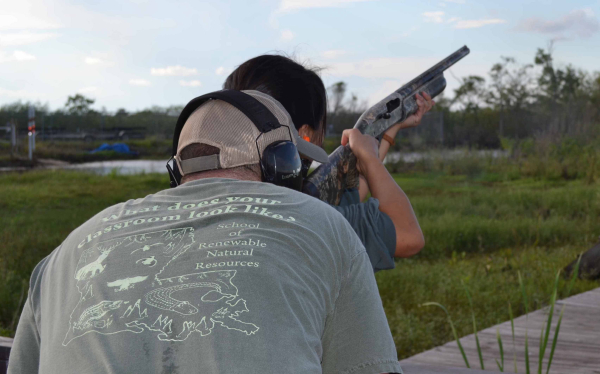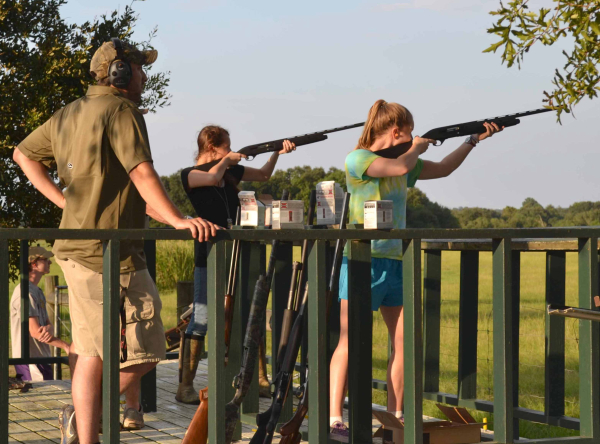 |
Using Collegiate Hunting to Develop Wildlife Policy Leaders
“Hey Dr. Collier, why do people hunt?”
By Bret Collier
Associate Professor
Louisiana State University
School of Renewable Natural Resources
Every fall during the first day of class when I outline the Collegiate New Hunter Program at Louisiana State University, one or more of my students asks me the above question. Now, as a university professor, I love good questions, because it shows that my students are thinking and engaged. But the question of why people hunt is something different, because as we all know, the answer is personal to each of us. My reason is that I love being part of my Illinois farm as it wakes up with the morning sun, and philosophically, that hunting on the farm is part of my being. For many of you reading that last sentence, you know exactly what I mean, hunting is just part of our existence, part of our history, part of us, it just is.

As a professor, I am supposed to have the answer to any question. Thus, I struggled when confronted with “Why do people hunt”? How does one teach about an activity that, should a student choose to engage in it, may change their entire worldview? In class we discuss how hunting is the engine behind conservation, and how hunters of all types have been the most vocal groups supporting everything from regulations to land conservation across the United States. But, words on a page and mornings in the marsh or the tree-stand are separate entities, and while both play a role in the training of the next generation of wildlife conservationists, I have realized it is incumbent upon us to not stop when the lecture ends, but to continue to expose students such that they can develop their own answers; not to the question “Why do people hunt?”, but to the question “Why do I hunt?” That is where Louisiana State University Collegiate New Hunter Program comes in.
As the current shepherd of the Collegiate New Hunter Program at LSU, I cannot take the credit for its initial creation. Dr. Frank Rohwer (President of Delta Waterfowl, previously an LSU faculty member) and Larry Reynolds (Biologist Director in the Wildlife Division, Louisiana Department of Wildlife and Fisheries) initiated the program when hunter education was added as a requirement for LSU’s senior wildlife management techniques course. Any student who successfully completed hunter education and bought a hunting license was provide the opportunity to go with Frank and/or Larry on a public land waterfowl hunt. Early successes were hard to come by, but the formation of a partnership between LSU and a private duck club in southern Louisiana in 2011 laid the foundation for the program to move forward by providing a early teal hunt for at least 12 LSU undergraduates each fall.
When I arrived in 2014, I inherited LSU’s Collegiate New Hunter Program, and a problem. When I discussed the opportunity on the first day and asked who might be interested in learning to hunt, 42 hands shot up in the air, which meant 42 students needed hunters’ education, 42 students needed camo, 42 students wanted to hunt who had never been trained in firearm safety and likely did not own a firearm, and I suddenly needed 42 hunting options. How could I, as a professor and mentor, preach the importance of hunting to the future conservationists in my class if I could not provide them with the opportunity to have that experience? Fortunately, I work at a University that was very supportive, and I convinced the LSU AgCenter to let me purchase some 20 gauge shotguns and I raided my closet (and quite a few of my friends closet’s as well) for old camo shirts and hats, and I brushed up on my hunter education instructor training so we could hit the ground running. The first night teaching hunter education to the college students was awesome! As we all know hunter education courses are targeted at kids at least 10 years old, so my college students asked some really good questions regarding how individuals transition between the stages of hunting, what kind of expectation they should have for their first hunt, including whether it was alright to cry when they harvested their first animal and whether they could take one home to eat (and if I could help them cook). They were hooked and none had even fired a shotgun or rifle yet.

Probably the greatest issue, and concern, during development of LSU’s Collegiate New Hunter Program is that of safety. My daughter is 9, and she knows what muzzle control is and where the safety is on her .22, how to check to see if it is loaded, and to never point it at anything other than paper targets. I never expected to be confronted with a situation where I would have to teach a college student what a safety was, where it was, or how it works. Yet here I was, with 42 students who had never held a firearm, eager to learn. Fortunately, college students have good attention spans and catch on quick, and with lots of time at the range and support from other faculty and graduate students who were experienced hunters, we finally reached the point where our students were comfortable with firearm handling and shooting, we were ready to send the students out on their first hunt!
More of the story to follow in the next installment of Conservation Pillars.
You can follow Dr. Bret Collier online at:
Twitter: @drshortspur
Instagram: @drshortspur